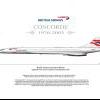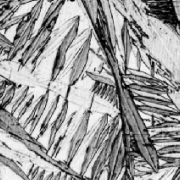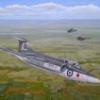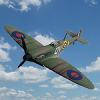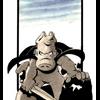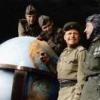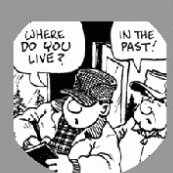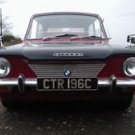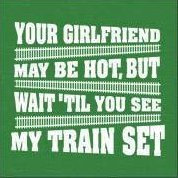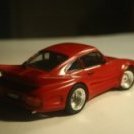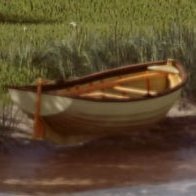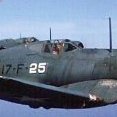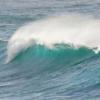Leaderboard
Popular Content
Showing content with the highest reputation on 03/06/19 in all areas
-
This is the latest in my BA Negus fleet. It's the Authentic Airliners kit with 26 Decals livery and AA cabin and cockpit windows decals. Halfords Appliance White and Racking Grey also a mix of Tamiya X3 Royal Blue and X16 Purple for the belly. Bare metal areas are Mr Metal Color Aluminium. Although not a difficult kit by any means this one has taken a long time mainly due to my procrastination and having too many other projects on the go at the same time! I have displayed it on the apron attended to by a couple of engineers due to problems starting the engines. The passengers and crew have all boarded and are ready to go. Hopefully they can get the problem sorted or the flight might miss it's slot! And here are a few 'with something else' shots! Thanks for looking and I hope you like it. As ever I look forward to any comments and criticisms. Cheers, Ian27 points
-
1/72 Academy F-4J. AC206 VF-103 'Sluggers', USS Saratoga, August 72. MiG-21 Killer. The excellent Academy kit, Eduard etch in the cockpit, Print Scale decals. Thanks for looking, Phil25 points
-
Hi all Completed the lovely Special Hobby Firefly T2, this is a nice kit to build and consists of the usual injection Moulded plastic, resin and phot etched bits. I enjoyed building this very much and will now attempt a T5 from the Special Hobby Mk5 Firefly kit and Pavla Firefly Kit which gives you all the bits to make a Mk1 or a T1/2 or a TT variant, so will use the rear cockpit section of this also. I have kept the weathering to an absolute minimum as they appeared to be kept quite clean, with just a bit of exhaust staining and oil leaking underneath. The kit does have some rather nice details and they can be seen on the WIP thread if you want to. The model was brush painted in Humbrol 56 Aluminium and 24 Trainer Yellow, brushed over with several coats of Klear prior to decaling. The Kit decals are superb and behave very well and are very thin too The Etched details are very nice (and fiddley, with the carpet monster devouring one of the rear view mirrors) Hope you enjoy the photos Thanks for looking in. All the best Chris18 points
-
And without prior planning, it is fitting that this build has finally finished to be presented in the week of the 75th anniversary of D-Day. ML196's role being to guide Landing craft along narrow mine-cleared corridors. I dedicate it to all those lost during Operation Overlord and Operation Neptune. Build Log here ML196 Fairmile B - Landing Craft Control Thanks for all the huge encouragement and support! (Photos restored 24.05.22 due to Village Photos going defunct) Thanks for looking Rob17 points
-
Last week I finished my Airfix Whitley. The kit was very nice. I added some Eduard brass, resin barrels, resin exhausts (2 sets for a Hurricane from SBS), and I replaced the front machine gun. The only truly troublesome part of the Airfix kit was fitting the front glass part over the front turret. Painted the exterior with Mig paints, and coated the whole thing with Vallejo clear flat. On November 8th, 1941, Whitley Z6948 was the first allied aircraft that was lost on the mainland of southwest Friesland, a Dutch province, during the war (aircraft had been lost in the IJsselmeer), it was also the first time that Allied service men were killed in action since the start of the occupation and as such the incident made a big impression. Build thread here: Here are the photos: The end Thanks for looking & feedback is always welcome.15 points
-
Latest build. Mark DSCN3432 (2) by mwsfly9, on Flickr DSCN3433 (2) by mwsfly9, on Flickr DSCN3434 (2) by mwsfly9, on Flickr DSCN3435 (2) by mwsfly9, on Flickr DSCN3436 (2) by mwsfly9, on Flickr DSCN3437 (2) by mwsfly9, on Flickr DSCN3438 (2) by mwsfly9, on Flickr DSCN3439 (2) by mwsfly9, on Flickr DSCN3440 (2) by mwsfly9, on Flickr DSCN3441 (2) by mwsfly9, on Flickr DSCN3442 (2) by mwsfly9, on Flickr DSCN3443 (2) by mwsfly9, on Flickr DSCN3444 (2) by mwsfly9, on Flickr DSCN3445 (2) by mwsfly9, on Flickr DSCN3446 (2) by mwsfly9, on Flickr15 points
-
Hi Everyone Managed to finish this last week after a long nerve-wracking slog My attempt at Special Hobby`s 1/48 Loire 130 Cl `Colonial` kit Built 99.9% from the box with just the pitot`s on top of the mast replaced with a home made item as my sausage fingers couldn`t handle the little resin bit Finished to represent an aircraft of: Section d`Hydroavions de la Marine, Cat Lai, Saigon, Cochin China, French Indochina late 1940 Apparently a few of these were still in use in 1949-50 so it fits in with my Indochina collection although I couldn`t cobble together any later decals. With it being a flying boat with no undercarriage I was a bit stuck on how to display it...... .. so I came up with it having temporary repairs away from base 🙄 Decals were from the kit Hope you enjoy, thanks for looking Cheers Russ14 points
-
Hello guys! I am happy with our Normal One and Liverpool! But now for the serious things: 1:72 Model Monogram built 1996, so 25 years old, nearly Oldtimer! Verlinden Cockpit, Microscale, a lot of scratch. hope you like it... Cheers, Tom14 points
-
Here's my 1/48 HS-129 by Esci (not the newest or best, but it was a 'wear and weathering' experiment) Hope you like ... Build and weathering found here ... https://www.britmodeller.com/forums/index.php?/topic/235055393-kursk-warrior-hs-129-panzerknacker-latest-photos-june-03-finished/ Thanks for looking, Colin13 points
-
Some time ago I built a Ferguson TE20, from a Heller kit, as shown in this thread: I have now built a diorama as a place to show off the Fergie. The scene is a farm yard right outside a barn. The barn is shown as a single wall, built in a typical Swedish 1800 or early 1900 fashion, but having survived in to the late 1900:s. All items, excpet the Fergie itself and the spade are scratch built. And yes, the cat is a photo 😀11 points
-
End? End? Let's not get ahead of ourselves here Pete. Steady on and all that. 😄 Doesn't even begin to cover it Keith. Remember standing at a bus stop aghast reading about it having blown up in the Evening Standard on the way home from college. Same air of surrealism Wells talked about at the beginning of The War of the Worlds, people continuing about their daily business &etc.... You do not jest. I guess in that period the cognitive psychology of flying was still in its infancy as an area of systematic study and analysis. Add into the mix the necessity to conduct such high-intensity operations versus the limitations of sensory response and the pressures to perform must place almost impossible demands on pilots in such situations. As ye know far better than me Crisp. Strong bread flour for preference Simon. This is a British aircraft..... The credit belongs solely to others Anthony. I learned to mix CA with flour from @Massimo by way of @giemme. I simply substituted epoxy in this instance to avoid any possibility of fogging the transparencies. Engine sounds were made earlier too Giorgio. (Though I must confess I've no idea what a Cheetah IX sounds like!) Agreed on both counts Rob. It's as if the radiation from the reactor X-rayed just how utterly fecked the USSR had become by that stage. Along with emphasizing the unbelievable heroism of ordinary men and women in the face of it all. If you're interested, Alexei Yurchak's: is a superb (and frightening) account of a society in which there was no longer any language left to question the system. I feel the weight of expectation in full now Steve! A process which shows no sign of ending at present Johnny! (see below) https://chernobylexplorer.com/ I share this fascination lads, but the appeal to narcissism (of the 'selfies at Auschwitz' variety) of this website is downright nasty given the life of all kinds that was destroyed. Innacurately-shaped wings. Engines too far inboard. Nose completely wrong. Looking at that photo I realize I've screwed up this build s-oooo badly. Looks like I'm going to have to vacform a larger windshield and make the wings shorter.... Supply/return runs for the oil tank have been added behind the firewall from scrap wire: Middle one is the supply line that goes straight out through the firewall to the front of the engine, end one there is the return that bridges the firewall via the oil cooller that sticks out of the side of the nacelle: On the actual aircraft that end meets of that pipe joins the left side of the starboard cooler which straddles the firewall (marked here by the locator holes drilled out previosuly): You can see that little of the inside section of the oil cooler is visible with the nacelle in place so I'll decide later whether it's necessary to build any kind of an internal respresentation for the ends. Most of the spare time (today being a Bank Holiday here) went on sorting out the visual appearance of the top of the fusalege. I'd posted previously the reprofiling of the top of the rear fuselage but of course it also required some kind of representative surface detailing for the stringers that meet at the apex of the tail. I didn't feel tha tthe kit moulding had a sufficient number of these anyway and aside from this, there are a lesser number that run along the roof of the cockpit which are noticable from a number of angles eg. in this beautiful image of N5331: Lots of luvverly detail visible areound the airframe there in that oblique sunlight. Having run out of those fine hair-like strips of Slater's microd now, I decided to experiment with lengths of fine cotton and Rocket Hot in order to start laying-out the stringers: Simplest approach was to tack one end of each length into place, pull out taught and tack the opposing end into place, then run a drip or two of the CA along the length with a cocktail stick and let capillary action do the rest. In this raw state of course, the raised cotton stands too proud of the fuslage so after brushing some of the Rocket Hot along the tops of them to make sure they are well soaked, they could then be sanded down flatter as I'm in the process of doing in the shot above. Next step was to give it a good thick blast of primer: This is necessary not only to check the height of the cotton (still too prominent at this stage shown above) but also to give some 'fill' between the lengths to that the 'scalloped' profile of the actual aircraft skin can be replicated. Note also how handy it was to have a spare turret to act as a protector.... 😁 After some prolonged sanding and filing with a small half-round, plus a painted layer of Mr. Surfacer to even out any non-uniformities, there emerged a roof that captures (hopefully) the presence of the stringers, without them being too exagarrated: In ths respect it's better for them to be 'just' visible, as opposed too being unrealistically pronounced in terms of surface relief. Same deal for the rear fuselage: Laborious and intensive work, but an improvement on the original in terms of visual veracity. Another of those archetypal jobs that if not done, you'd be forever kicking yourself for ignoring. Plain primer of course renders such detail in starker terms than the final camouflage and markings will give it, so I'm conscious some of it will recede even futher under a final overlay of colour. That's it then for this evening. Another significant bit of progress on the main structure. After doing so many fiddly little bits for so long it is rather pleasant to be doing big, obvious parts of the aircraft again! Tony11 points
-
The Yakovlev Yak-28 (Яковлев Як-28) was produced initially as a tactical bomber, it was also manufactured in reconnaissance, electronic warfare, interceptor and trainer versions, known by the NATO reporting names Brewer, Firebar, and Maestro respectively. Based on the Yak-129 prototype first flown on 5 March 1958, it began to enter service in 1960. Yak-28L (Izdeliye 28L; NATO reporting name: "Brewer-B") was a tactical bomber with ground-controlled targeting system using triangulation from ground-based transmitter sites. A total of 111 were built. The build was a trial all the way. By comparison, Airfix kits are shake'n'bake. A six-footer at best.10 points
-
Hi I went to Old Warden to see the seven Daks. The airfield was very busy, due to the season premiere of the Red Arrows. The Dakotas departed using the radio callsign "Dakota 44". Here are a few Dak pics (with a Blenheim image thrown in for good measure!) Other air show pictures to follow, if anyone is interested?10 points
-
So I have Gripen, Viggen, Draken and Tunnan standing in the cabinet, so time for probably the least well known of SAAB's famous(?) five: Aircraft 32 Lansen. The plane itself is probably the most normal and conservative of the five, and to the ebst of my knowledge didn't really push any cutting edge technology or go for some original solution to things. Created in the late 40's and early 50's to replace a range of WW2 vintage aircraft (SAAB 18 and 21, Mosquito) the first version to show up was the A32A attack/strike aircraft. This as followed by the J32B, an all-weather fighter with new engine, guns and avionics, and then the S32C which a recon version of the A32A, swapping the guns for cameras. Later on a number of J32B were rebuilt to J32D target tugs and J32E electronic warfare aircraft. For this build I had a bit of a dilemma. Available kits in my preferred scale was a not quite fresh A32A/S32C Heller kit showing its age in more ways than just the raised panel lines, and the much newer but reportedly still not all that brilliant Tarangus more-or-less-short-run J32B kit. The latter did seem like a better idea, but I'd rather build an A32A. I could probably mostly fix the nose, but the engine was probably a bit much for me. Then as I was flopping around with other aircraft I kept having the idea that I really should get some solid panel line re-scribing practice in. And so I think you see where this is going, Heller it is. The whole thing arrived in a bag, with the staples holding the card top in place being heavily rusted. What am I doing to myself... A first check of the fuselage Oh dear. But it should be workable even without the bench vice if I just take it section by section. The canopy seems quite clear, once I buffed out the scratches from banging about in the bag for a decade or three. It's tank armour thick though, so no reason to bother all too much with the cockpit (which has details, though quite soft and faint such). A quick additionw as amde though, as these will be bright reed pieces sitting right under the canopy and their absence thus easily missed. A quick cockpit paint-job later (I guess I should point a camera in there at some point before the canopy goes on) and the part by part gluing gets going. Starting with the upper rear. That done I glued the wings (single underside and separate uppers) together and dry fitted some assorted bits together. Well, that's an aircraft. Now if only the gaps were as benign as it looks in the photo.9 points
-
Avro Shackleton MR.3 201 Sqn, St. Mawgan, 1964 I thought I would get this one posted up before the new Revell kit appears. This is of course the Frog / re-issued by Revell kit. Decals are straight from the Revell issue and were very good. Lots of rivet removal and re-scribing were the main features. The operating bomb doors, flaps and tail surfaces were a nice feature of the kit which didn't distract from scale appearance.9 points
-
My fifth completion of the year (though the only one in 1/32), the HobbyBoss Republic F-84G Thunderjet in the markings - of which more below - of one of the aircraft supplied to the Armee de l'Air in 1952: The kit was built almost OOB though I did add a TetraWorks US Seat Harness set to the cockpit and used the Eduard canopy mask set designed for this kit. I also added a couple of extra wheel-balancing weights under the cockpit floor but I suspect the metal noseweights provided with the kit would have been enough. The kit was painted in Alclad Duralumin with some areas painted over in Vallejo Metal Colour Dark Aluminium as most colour pictures showed a distinct variation in the shade of metal around the cockpit and the jet-pipe outlet and the rudder. The interior was painted in Colourcoats US Interior Green and Zinc Chromate Green, the wheelbays and airbrake bay were painted in Yellow Zinc Chromate dulled with a little buff colour to 'age' the paint a bit. The wing stripes were painted in RAF Night and the wingtip tanks in RAF Yellow. The aircraft codes, squadron badges and most of the serial numbers on the tail were from the kit transfers, as were a couple of the stencils, but the majority of the kit's transfers were unusable due to having something spilt or splashed on them which rendered them irremovable from the backing sheet. They came in the kit in sealed bags, so this was not something I am prepared to take the rap for, but I don't imagine it is a common problem with HobbyBoss as I have not heard any other complaints about their transfers. The remainder of the markings and stencils were from the Berna Decals set for the F-84G, they were absolutely fine though the roundels/cocardes in the Berna set were significantly smaller than those provided with the kit, and had the yellow outline which the kit ones lacked. I don't know if this means I have a more, or less, accurate kit but all the pictures I have seen on the internet of French F-84s seem to carry the smaller cocardes. Anyway, I enjoyed building it and it's nice to get another notch on 2019's bedpost Cheers, Stew8 points
-
Tony I must thank you for that suggestion. - The thought never occurred to me to 'weather' the handles as I had it in my mind that this coach was kept in such ultra-pristine condition I wanted to display it that way. I bought some oil paints about 2 years ago, and this was my very first opportunity to use them. Thanks!!! To take the Fnaarring a step further... your small parts must be a bit harder than mine. No matter how gently I try and stroke/caress/rub them, I always break the skin and get some breakthrough. I've lost count of the times these parts have been sprayed. Moving on... On the vestibule end, there are some electrical doodads hanging off the body just below the window. There's a cable hanging out the bottom end of the doodad and a plug attached to the cable (to be addressed in a future episode). I had made some of these a while back (probably a couple of years ago now!) but I wasn't happy with those so I remade them - this time paying attention to the runic symbols on my lathe and getting 4 pieces which are almost the same size... give or take. I drilled a hole in each one and added a small length of brass tube which, if the planets align, will provide a fixing to hold the cable in place, sorta like the one shown at the bottom of the strip. now painted and waiting for a gloss coat... and cable... and... On to other things. Okay, it's still the vestibules but we're not talking paint any more. I actually got a couple of coats of clear gloss on the ends. (The micro drill is just there to provide something for the camera to focus on). Moving from a painting stage to a clear coat stage is a major milestone for me. A pivotal moment. I have spent so long developing my phobia of painting that getting from a painting stage to a clear coating stage is a major moment in the build for me. It odesn't matter that clear coating is still in fact painting - and I still have the phobia to deal with, but as far as I am concerned, I just put one stage of the build behind me! and in an even more panic driven mode, I got some clear coat on the side frames. This is a moment I have been trying to get to for several years now It doesn't look too bad. It's not perfect by any means, but it's not too bad. A closer shot... That will get a micromesh once fully cured followed by another coat or two of clear I came to the realization (finally!!!) that this was never going to be perfect. I'm just not very good at doing perfect. I'm sort of okay at doing not bad, and every now and then can come up with a 'quite good' but I'm just not good at doing perfect at all. Between my phobia of painting and my lack of skills in said art, if I waited until things were perfect before moving on.... well, I've already been at this for 5 years now. I decided that rather than focus on the individual blemishes and faults, I have to look at the job as a whole. That means, yes there will be a fleck of who-knows-what in the final paint job, but I think the transfers will go a long way to making the eyes look at the carriage, and not a small blemish. One day it will be complete8 points
-
This was my first project for the Panzer VI Tiger STGB. My second, yet to be started, project in the Tiger STGB is going to be a crossover project with the D-Day GB so I wanted something to occupy me for a couple of weeks until the D-Day GB actually got underway - and the result can be seen below. It was actually a really fun kit to build. I had planned on it being a completely OOB project but I realised something I already knew - and had put out of my head - that Porsche turret KTs (apart from a couple) all had Zimmerit. So, even though this is a Toon kit, I was pondering how to do the Zimmerit until @MarkSH mentioned in his thread that No More Nails seemed to be a good product for representing Zimmerit. Luckily I had a Zimmerit tool in a 1/35 Academy Tiger 1 kit in the stash so, following the buying of some No More Nails from the local hardware shop and a bit of practice on some scrap, I applied it on the kit. It's not the best ever home-made Zimmerit I've seen but it looks okay and I'm pleased I've had a go - I have a couple of 1/48 KTs that will require some Zimmerit and there doesn't seem to be any etch or other Zimmerit out there for them. I know these kits arn't to everyone's taste but, as a quick, fun project it was great! Kit: Meng Toon Kit (no scale given) Paints: Humbrol, Revell, Citadel and Railmatch Acrylics all applied by brush Extras: No More Nails Zimmerit (thank you to MarkSH for the idea), lead wire and Vallejo Mud products Base: Wilko's small picture frame, 3mm MDF, Polystyrene from frozen Pizza box packaging, household filler, Woodlands Scenics Turf and Course Turf plus a variety of army painter tufts and plants. WIP: Here These photos were taken against the sky background from my Spitfire display shelf: Some photos against a white background: ....and on it's picture frame base: Thank you to everyone who took the time to comment in my build thread. Kind regards, Stix7 points
-
Greetings all, I'm in with a fairly large ensemble, the Missus' has already expressed concerns over the eventual location of this lot!: Revell's re-boxing of Italeri's LCM 3. Its a big enough box to fit all this stuff inside as well. The hull of the Boat with a Tamiya pot for scale.....I might be starting to share my Wife's concerns! It is a large model, but it also has some nicely rendered detail and a fair number of small parts. Cheers, Mark.7 points
-
Eduard's boxing of the Hasegawa Hawker Typhoon, with Resin 4 blade prop, and elevators. Painted with Tamiya acrylics throughout, weathered lightly with some oils and pastels. Lost one rocket, so it's being re-armed 🙂 Peter7 points
-
Sopwith Camel Trainer H823, 43 Training Depot, Chattis Hill, November 1918 Not a bad kit, the transfers are a huge improvement, but the forward upper decking and lower wing location needed a little attention. Nothing drastic just a bit of extra filing. Regards, Steve Regards, Steve7 points
-
Something has been done! Internals started, other bits cleaned of flash, pilots given a first coat: I fancied glueing something so cut the wings off. Had to shave some ejector marks off the insides but then stuck 'em together with Liquid Poly: Better than nothing. Just.7 points
-
Hi Folk's,this weekend's progress.Painted the interior and added tape belts,cut out the blob that was passing as the front seat and added a spare.Fuselage join was flawless cleaned up the seam's added tailplanes.The canopy looks like a good fit too.7 points
-
Thanks to the generosity of @JOCKNEY I offer the following for this GB. Parts moulded in sensible black styrene... The extensive decal sheet with it's super accurate markings. Who needs after market? The clever FROG designers managed to expand the construction to 13 stages! Yes 13 before you referred to the box base for the extensive paint guide. I wonder how many ever noticed or even cared about the missing bar above the 'E' code on the starboard side???? That's before the complete lack of continuity with the paint scheme on the rather splendid box lid. A final observation shows just how young WW2 pilots could be. From the top of his motorcycle type head gear to the bottom of his tiny feet he's a scale 1.5M tall. This could be explained by the lack of any face mask which would obstruct Prune's enjoyment of a good healthy smoke at any point in the flight. I believe that when the RAF refer to squadron seniority they are referring to the age of the pilots in the Class (sorry Squadron) rather than the 3 minutes earlier than the next squadron being formed a few years earlier. Having read up on this aircraft both on the instruction sheet AND going through my Commando books I can see that this is obviously a new level in detail and accuracy, there is just the one wing either side, a single fin, 3 bladed propeller, canopy and a comfy high back chair for the Gentleman of the Air crew compliment. I doubt my confidence to do this magnificent model justice as I appear to have misplaced my Pith helmet. However I shall gird my loins and think of England.6 points
-
Yet another kit joins my build list. This one came out of nowhere, with Heather offering the kit to anyone who fancied having a go at it. I jumped at the chance! Thanks Heather. The kit provided is a re-release of the 1970 FROG one. The one I'm starting here it bagged but not boxed. There's a made in the USSR stamp on one of the sprues but no other info. The moulding is pretty poor with loads of flash and clear signs of mould deterioration all over the place. None of this is Heathers fault, I hasten to add! There's a decent build in there, but it will take a bit of getting at, and with the current Airfix kit being a far better bet, why bother in the first place? The reason I grabbed at the offer was because I would like to build this model in one of two ways. First possibility is as a wartime Identification model. Simple black finish overall and displayed with period ID stuff. Here's a couple of fake ID models I built out of basic plastic models a year or two back... The other idea that is growing on me all the time is to build it as a Penguin model that never was. That would involve a bit of retro building of a different kind. Cockpit detailing would be needed, but to thirties and forties Penguin standards. likewise the undercarriage, transfers and clear parts. Heather has provided the raw material, it's down to me now. I've fought the basic parts into Whitley shape already just to get things moving. Nothing lined up, with generally appalling fit everywhere. Much sanding, clamping supergluing and cementing got me an airframe to build from. It does look like a Whitley , and that's a good thing. I really like the nose down flying attitude the thing had. If I go the ID route I can set it on a stand showing its rather odd flying style. Here's the parts and work knocked out so far... And here's things set against a plan in the 1940 issue of Aircraft of the Fighting Powers. The plan and plane disagree in a few areas... ...mind you, it's still far closer to being a plane than a wartime Airyda 1.72 scale wooden kit is... Thanks again Heather, I'm going to have fun doing this one. Tony.6 points
-
Evening all, just finnished my first ship (usually aircraft). During the build i got inspiration and tips from the site which helped me alot. I have 'in progress pics' which ill post later so others dont have to learn the hard way like me lol and might find some of the info helpfull. alot of the painting was airbrushed and the decks were coloured using a wash (which i stole off Youtube). The PE was Eduard off ebay for 15 quid. Some bits i would do different but we learn as we go!!6 points
-
Got this one finished the other evening. Basically the Revell(current boxing) kit with lots of sanding and filling. Replaced the wheels, (which looked too large) from my spares box of wheels and a load of nose weight!!. Decals by Old Model Decals of New Zealand featuring the late scheme 727 of 40 Squadron RNZAF. Chose this option as the fuselage of the real one exists at RNZAF Woodbourne near Blenheim NZ. Noted it when I was down there touring the area after a visit to Omaka nearby. Not too sure about the light blue...it looks a little to bright /light when compared to pics of the real thing. A new purchase from S&M Models at the recent Lancing Model Show with the decals arriving a couple days later. No hanging about. PS: Some of the stencil decals came from the kit sheet and others from the new decal set. In particular thrust reverser decals and wing leading edge landing light decals from the kit. Had to corect the Am decals too. For example the little portholes in the main doors were too low and so use the kit ones which I cut away from the Germania markings6 points
-
Nice kit (Hasegawa, first one I've made and most impressed), IsraCast conversion a bit woolly and indistinct but nice PE, decals were excellent. To see the fun build thread, click HERE Weapons from Hasegawa Weapons set and the Python AAMs were from Paragon. Used Xtracolour and WEM enamels. The Xtracolour Sky/Green was a bit indistinct so probably should've given it another coat, but to be honest I couldn't wait another week or so for the Xtracolour to dry! Weathered with Flory wash and finished with Testor's Dullcote. No other weathering as in all the photos of these planes they look neat as a pin. Clearly, a lot of pride and a budget to match in the IAF! Decided to build it in flight as these machines look about as mean as fighter jets get! Tried to do it justice, but there's a lot I could've done better if I'd taken a bit more time. Thanks for looking, Al6 points
-
Hi All Ok, so I'm with Revell up to getting the fuselage halves together Gaps and seams all over, but nothing out of place The main structure is like one of those puzzles that everything is loose until the final piece. Big tabs on the wing roots are part of this They slot in the forward engine housings and fit against little supports. Not going to glue them yet though The rear engine / upper engine ducting is only glued where the engine halves join And the tail fin slotted between them, still unglued As it needs to expand slightly to slide over the top of the body, still unglued It's now all still slightly wobbly, but here's the key. The lower plate can now be squared off on the forward fuselage (covering some, but not all) of that beautiful seam This is where there is some nifty fitting Pegs on the bottom plate locate those big lugs on the wings, and the whole thing can now be glued up taking care to keep it all aligned. Paint it all white! Done this way, the engine module can be assembled and painted independently And slotted into position, without the need for all that tooth curling masking Nose leg just fits in the slot The back legs are not as straight forward, but at least you can get a finger in and secure them This is all theory and conjecture, feel free to point out the bleedin' obvious. Comments and suggestions welcome Cheers Steve6 points
-
that's it in a nutshell Heather. I think I took those side-frames back to bare brass on at least three separate occasions. The last thing I want to do now is have to take them back to brass yet again... a couple of years work down the drain! Thanks for the info too. I'm a mechanical bod so never paid any attention to the electrics while I was designing this car - we had an electrician for that. I just know the electric goes really, really, really fast from one end to the other and makes things light up, heat up, or make things go round and round6 points
-
Hi all, A bit of progress, which is a bit difficult this time of year as apparently there's a garden out there (good thing its raining!) I'm fairly basic with my painting, I stick to Xtracolor for airbrush work and the decals go on really well. No messing about with additional gloss finishes. A coat of PRU blue and the black and white for the invasion stripes. Which are a topic in their own right: Thanks to @Giorgio N for his observation about the width of the back white stripe. This prompted me to do a bit of analysis on the only available photo I'm aware of: I measured the widths of each stripe, as best I could, and put the results in a spreadsheet to calculate the widths of the individual stripes: Some might think this a bit obsessive... Studying the photo made me think about the location and size of the fuselage roundel, which stuck me as bigger, or at least higher, than the one on Xtradecal set X72-105, but I'll leave that problem till I apply them. AND, if I'm right, the canopy is missing in the photo? I also agree with @ben_m that the stripes would not have been applied in a hurry. Probably quite carefully by an Aircraftsman under the watchful gaze of his Flight Sargeant. So I just need to measure, cut and position the masking tape to 0.01mm, should be easy! Mask the rest of the model: You might have noticed the airbrush? An old Aerograph "Super 63". Probably not the latest technology, second hand when I got it 25 years ago. Works fine. With Xtracolor, any masking tape needs to be removed while the paint is still soft, or you get a distinct raised line, luckily it all came off OK. But I have had a few mishaps at this stage. So far OK I think. Looking forward to the decals! Charlie6 points
-
Here's my Airfix 1/48 Hunter F.6 built as XF383 of the Day Fighter Combat School, RAF Stradishall, 1961. Build thread is here thanks for looking Julian6 points
-
Cloned from my 1/72 model to 1/144 with modifiction to rear fuselage. Last photo - 1/48, 1/72 and 1/144 together. IMG_0229 by ravodavo, on Flickr IMG_0230 by ravodavo, on Flickr IMG_0231 by ravodavo, on Flickr IMG_0233 by ravodavo, on Flickr IMG_0232 by ravodavo, on Flickr5 points
-
Hi all, I'm also in with the AMT/ERTL 1/48 Douglas A-20G Havoc as an aircraft named 'Joker' of the 410th Bomb Group/647th Bomber Squadron. I'll be doing the aircraft specific decals as home prints, the artwork for which is already underway. A fairly simple kit, but the plastic seems a little soft and the fuselage halves in particular are very bendy and will need to be treated carefully with the possible inclusion of some internal sections to avoid any twisting or distortion later in the build. The kit cockpit isn't too bad but I spotted this Vector set at SWM last year so thought I'd give a full resin cockpit a go. Cheers, Mark.5 points
-
So, before the CMR Wapiti was released the only way to build the Wapiti, The Indian Air forces first mount was to modify the Frog/Novo Wallace or the merlin models plastic and White metal Wapiti. The less said about both the better!! I used the Merlin fuselage and undercarriage, Wallace wings and empennage, Aeroclub white metal Jupiter engine, a paper clip for the Lewis mount and a small brass Russian cottage lewis gun. Vallejo paints and sprue rigging with spare decals. A basic no-nonsense build with no bells and whistles that ill keep for the CMR kit!! The aircraft is from the IAF's No 1 Sqn the Tigers at Miranshah when operating against Afridi tribesmen on the NWFP circa 1933. . .5 points
-
5 points
-
I like Inkscape as it is free and much simpler to use than many of the professional packages. I am a real amateur at making decals, however I made the following fairly easily after a few trial goes: HTH Mike5 points
-
zzzzzzzzzzzzzzz I will footnote where I wish Or even addanasterisc but whatever, odd things happened this afternoon Look, suddenly the floor, seats and door dinghy pack all slid inside the fuselage and were glued in place (after refitting two of the seats that fell off ) And the nose was glued on too, suddenly a Sea Kingly aeroplane appeared out of the gloom And Colin's beautifully crafted Perspex tail was readied for the taail end And Superglue worked its voodoo on its juju Bodyworks can now ensue, yippeeeee Yesss I will take that, get in! Time for fillers, Milliputs and EIHRSC and SIHRSC to earn their keep5 points
-
Hi All, Just to show that I don't only do cars and bikes, I present the Italeri Douglas A-26C. It was bought for my son many years ago, and he had built it to a high standard, but had not completed the painting or decaling. I didn't have to do much to finish it, and it languished on the shelf for three or more years without wheels and still with all the masking on. Anyway, I finally made the last push, put the undercarriage and bomb-bay doors and wheels on, and here we are: On the whole, an enjoyable build. My son enjoyed what he did, but A-levels and a degree got in the way, and he hasn't got back into the hobby yet. I'm afraid, I can't claim all the glory for this one. Thanks for looking, Alan.5 points
-
Kev, John, Matt and Steve - Huge Thanks. I declare this build finally finished after 25 months! My first attempt at extended scratch-building, inspired by you all but especially Kev and John. Thanks Fellas. I'm still not certain that we present information in an accessible way for beginners (To scratch building etc) As a close down thread here are some reflections. First off get LOTS of Plasticard strips in as many different sizes as you can - same for sheets and rods. So if you are thinking of having a go - DO IT. Here are some of the tools that I've found useful The Tailors rule was had for a few pounds from EBay and makes cutting plastic sheets Soooo much easier. For thick sheets I use the orange scriber, if they are very thin the narrower black scriber or a heavy duty scalpel blade (Swann & Morton 23 on a No 4 handle) For cutting rod or strips square - I find this invaluable (Though there is a limit to the thickness that it will cut) "Squaring off" is problematic and I use these to accommodate - the little set square came from USA via Ebay but was reasonably priced Kev tipped me off to the next item which is possibly the single most useful thing I use, not cheap at nearly £25 but worth every penny. I have a sheet I've put together for scale feet converted into millimeters which eases up working from the Lambert books etc I picked this tip up along the way - the use of Acupuncture needles to apply Superglue (Loctite gel). Cheap as chips from EBay and couldn't do without them now!! And finally a quick pictorial summary of paints and weathering products And so here's to honourable mentions about specifics: MTB Hulls - Christian moulds superb hulls, check his site out - Marvellous Coastal Craft Models - Suppliers of whole kits, but more importantly some essential weapon and accessory sets - Marvellous Sovereign Hobbies/Colourcoat paints - Our very own Jamie Duff whose paints were a major revelation. The thought of using enamels was initially utterly underwhelming. Once used I'm hooked - superb colour representation and really easy to use. Using his Thinners - smell is kept to a minimum and drying times closely match those of acrylics. I completely buy into his revisionist thinking about wartime colours - Utterly Marvellous Gunthwaite Miniatures - Again our very own Al Gunthwaite who produces Fabulous figures that bring alive models. I'm waiting for his Mae West figures hopefully with tin helmets (hint, hint Al!) that would really have complimented a D-Day build. As it is, I love the range which includes all kinds of informal naval dress - Marvellous Name it - that produce excellent, reasonably priced name plates that to mind set off any model. Micro-Master/Shapeways - If you are into coastal craft, you'll find lots to excite you! The Flot-a -nets were a discovery!! Coastal Craft Histories - Mark Smith - His volumes are all inspiring but Volume 3 with his wonderful graphic portrayal of ML196 set me on this path - Thanks And so with the RFI here Fairmile B ML196 Landing Craft Control, it's a final sign off .............. I've learnt loads, it's been frustrating at points and has taken too long. Special Thanks to Danny and Longshanks who both stepped in when most needed Signing off and Thanks to Y'all once again Rob5 points
-
With the Kinetic kit announced for June it's sure worth waiting for this before deciding on a 1/48 F-104, promises to be the best around but of course only when the sprues are in someone's hands we'll know if the promises have been kept. Regarding existing kits, first let me say that the Italeri kit is a rebox of the hasegawa F-104g, so whatever I say about the japanese kit applies to the Italeri offering. Revell also reboxed the Hasegawa kit in the past but as they reboxed the Monogram kit as well, better check carefully before buying a Revell Starfighter. Last but not least, Eduard issued two boxes with the Hasegawa kit and some extra parts, one for German aircraft and the other for NATO F-104Gs The Hasegawa kit is very good but not perfect. I'd say that for most modellers it's good enough, as most of the problems are of little details. What many don't like is the treatment of the surfaces, covered in recessed "rivets" that are not very realistic. Said that, they sure show less on camouflaged surfaces than on those painted in metallics, so may be fine for a German or Italian aircraft in the timeframe you're interested in. Now the Hasegawa kit represents a G, so fine for a German aircraft and for a number of Italian ones. As such the kit has bulged main whell well doors and the wider wheels of this variant. The kit also has a selection of exhausts, the standard "short" exhaust used on the original Gs and the longer variant retrofitted on all German Starfighters in the '70s. Both the Lockheed C2 nd the MB Mk.7 seats are included, both Italian and German Gsstarted their life with the C2 and then received the MB in the late '60s. Overall, apart maybe from some small details (don't have the kit in my hands at the moment), you can easily build a German aircraft from this kit. You can build a number of Italian aircraft too, but Italy also used the S variant. This featured a number of differences that are not well covered in the hasegawa kit, or in any 1/48 kit. It is of course possible to add these to a model, but I'd wait to see if Kinetic will offer them in a specific box. Italian Gs remained in service with 3rd Stormo into the '90s in the recce role, 6th Stormo replaced them with Tornado in the '80s, a number were used for training by 20th Gruppo while all others had been replaced with the S variant during the '70s. Another option for an S is the famous Daco correction and detail set, specifically made for the hasegawa kit. This set offers a large number of parts, including some specific for the S. The set also has details for German and other aircraft. The second best option at the moment is the Monogram kit, reboxed by Revell for example in the latest Tiger Meet box. It's an older kit, with raised panel lines. Detail is pretty good, as per Monogram tradition, but fit can also be tricky. IIRC this kit lacks the bulged doors and the wider tyres but I may be wrong. It also lacks the longer exhaust, so would limit your marking options to German aircraft before receiving the update... or Italian ones, as Italian Gs didn't receive this update. Now price is a very personal thing and the same applies for things like accuracy and details. The very best representation in terms of accuracy and detail at the moment is IMHO with the Hasegawa kit plus the Daco set. Second best would be the Eduard reboxes of the same kit. Third best would be theHase kit alone and distant fourth the Monogram kit. For completeness, fifth would be the Esci kit and sixth the original Revell mould from the '70s. Pricewise of course the Revell rebox of the Monogram kit can be found at a third of the price of the Hasegawa one and half of the Italeri rebox, Best value for money are maybe the Eduard offerings. Said that, someone told me that the aim of the Kinetic kit was to improve on the Hasegawa kit by removing all inaccuracies and adding details that not even Daco included, so this kit promises to be really the best option.5 points
-
Welcome Steve! Thanks Tony, but I can't stop the passage of time… 65 now and counting… but nice Birthday weekend with the girls. I think the extra 'nurses' are going to work out and I've finally caught up with my 'followed' threads and been inspired, as usual. Who knows, I may even get some modelling done later. Fingers crossed!5 points
-
Well had to do it. This is the canopy in place using the rebated ledges. It is still very rough, but it works.5 points
-
I was extremely glad to see that my Xtradecal sheets had some suitable sizes of roundels! Well it’s late and I’ve had a good run: I think I’ve got a Falcon canopy for this somewhere, so I might be prising off the lid tomorrow! Thanks for looking, Adrian5 points
-
Hi All, A long weekend here in New Zealand (Queens Birthday), so a chance to catch up on bench time. I found this some time ago on the net. No, it's not to scale, I measured it out, but comes in handy for helping with the bomb recess on belly of aircraft etc. The Skua Mk II (according to Wiki.....) is 10.85m in length, which is 150.69mm in 1/72. I had to include the propeller nosecone to make it to 150mm Given I don't have any accurate 1/72 scale drawings of the Mk II Skua, model accuracy is questionable, as are any modifications to say the least. So I made an executive decision, it's mostly OOB for this GB, apart from the PE and scratch built items So starting with the cockpit (using that excellent resource Building the Skua I posted above), I did away with kits seats and scratch built the pilots seat I cut out some PE from the Airwaves fret which has a set of "stringers/ribbing (all 1 dimensional I know) for fuselage side walls Fit is quite good on Starboard side Not so great on Port side There is a plastic extrusion (to help support the cockpit deck to stay straight(ish) when gluing fuselage halves together - that needs to go, so out with a chisel While sorting out the fuselage halves, I decided to measure and mark the bomb recess That's all for now, more soon. Thanks for looking in Regards Alan5 points
-
Hello Dears, Mmmmhh Rigging scheme is … Well impressive I will ask for a lot of EZ lines methink !! You know what ?? For a first, I will not try to make the lower decks and the steam machine Whatever I will do, will be no more than educated guess since there is no documents ! Of course !! In my first post I talk about Dahlgren And ?? And…. It is blakely one Indeed !! This one is special to shoot rugby ball, more effective perhaps ??? Worked on the trenches or seam… As you want to see it !! Now this is a barrel or a gun… A Blakely in fact !! Ok Dears ! Thanks for watching ! Have a great modelling time ! Sincerely. CC5 points
-
Ooh, looking nice! Like you, I have something of a painting phobia which I find hard to overcome. For me, it’s mainly the fear of completely screwing up the paint finish after a long and painstaking build sequence. Anyway, the dangly doodads - quiet at the back there! - are electrical connectors. Each coach has a dynamo driven by a belt from one wheelset, which charges a battery of cells in boxes under the floor. These provide power to light and sometimes heat the coach. The connectors join the train up so the guard (or conductor, depending on which side of the pond you’re on) can turn all the main carriage lights in the whole train on or off, rather than having to traipse the whole train and switch things in each vehicle. I hope that made sense!5 points
-
I would but I use them for pretty much everything Tony already stated. The key thing is that they are square and parallel to within a few microns so are great for making sure your joins are square. They are also mass produced so can be had relatively cheaply. Basically they often used as a set-up tool in machining operations. This thread gives some insight into the myriad of uses. I can just see Ced now.... ...... and here she is with both wings fitted, and 35 minutes at 375 degrees... (the internet huh? wot did we ever do without it?) nice work with the frosting there Tony5 points
-
Calling the Crabber finished inside and out Oars, boathook, thole pins rudder and tiller. Mizzen plus outrigger and mizzen sail (used to steady the boat when fishing. If anyone noticed that the centre thwart was missing the knees, this was so that it was removable when fishing to give more space. Thanks for looking Kev5 points
-
5 points
This leaderboard is set to London/GMT+01:00





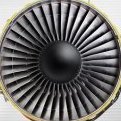

.thumb.jpg.b4a5069fd2c2dd5708ce1694345c5b11.jpg)
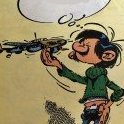

.thumb.jpg.d17ff607fc7e89ed057e63fcb6f2a888.jpg)


(250x229).thumb.jpg.48a57772b41ed148fdc8d15e3c202763.jpg)


